 喹酸(oxolinic acid,OXO)和氧氟沙星(ofloxacin,OFL)检出率较高,FLU平均质量浓度最高;鱼类体内∑QNs含量范围为17.1~146 ng·g-1,其中环丙沙星(ciprofloxacin,CIP)和FLU平均含量较高.生物累积系数(bioaccumulation factors,BAF)范围(L·kg-1)为96.2(BAFMAR)~489(BAFCIP),表明QNs在鱼类中的生物累积能力较低.5种检出率较高的QNs[恩诺沙星(enrofloxacin,ENR)、FLU、马波沙星(marbofloxacin,MAR)、诺氟沙星(norfloxacin,NOR)和OFL]的营养放大因子(trophic magnification factors,TMF)范围为0.714(TMFMAR)~1.33(TMFENR),其中ENR呈营养放大,FLU、MAR和QNs呈营养稀释.理化参数与BAF和TMF相关性分析结果表明,pH、T、SD、DO、COD、TP、TN、NH4+-N、NO3--N和PO43--P与BAF和TMF相关性较为显著.健康风险评估结果表明,CIP的危害系数(hazard quotient,HQ,0.0040~0.026)显著高于其它QNs(≤0.0050),危害指数(hazard index,HI)范围为0.0010~0.035,具有高健康风险.因此,应制定更为严格的抗生素排放标准,减少湖泊外源有机质和营养物质输入,以减少污染物在鱼类体内的生物累积,降低抗生素污染水平和健康风险.
喹酸(oxolinic acid,OXO)和氧氟沙星(ofloxacin,OFL)检出率较高,FLU平均质量浓度最高;鱼类体内∑QNs含量范围为17.1~146 ng·g-1,其中环丙沙星(ciprofloxacin,CIP)和FLU平均含量较高.生物累积系数(bioaccumulation factors,BAF)范围(L·kg-1)为96.2(BAFMAR)~489(BAFCIP),表明QNs在鱼类中的生物累积能力较低.5种检出率较高的QNs[恩诺沙星(enrofloxacin,ENR)、FLU、马波沙星(marbofloxacin,MAR)、诺氟沙星(norfloxacin,NOR)和OFL]的营养放大因子(trophic magnification factors,TMF)范围为0.714(TMFMAR)~1.33(TMFENR),其中ENR呈营养放大,FLU、MAR和QNs呈营养稀释.理化参数与BAF和TMF相关性分析结果表明,pH、T、SD、DO、COD、TP、TN、NH4+-N、NO3--N和PO43--P与BAF和TMF相关性较为显著.健康风险评估结果表明,CIP的危害系数(hazard quotient,HQ,0.0040~0.026)显著高于其它QNs(≤0.0050),危害指数(hazard index,HI)范围为0.0010~0.035,具有高健康风险.因此,应制定更为严格的抗生素排放标准,减少湖泊外源有机质和营养物质输入,以减少污染物在鱼类体内的生物累积,降低抗生素污染水平和健康风险.
抗生素作为一种抑菌和杀菌化合物, 被广泛用于人类或动物的疾病治疗, 常用于畜牧业和鱼类养殖中以促进动物生长[1, 2].据第三届畜禽养殖污染防治与资源化国际会议数据统计, 我国畜禽养殖抗生素年使用量达9.7万t, 占全国抗生素年消耗量近50%.抗生素因其分子较大, 不能被机体完全吸收, 约90%以母体化合物或代谢产物随粪便或尿液排出体外[3, 4], 最终进入水环境[5].研究表明, 即使抗生素处于低浓度, 对水生生物也会产生负面影响[6~8].不同来源的抗生素长期输入, 呈现假持久性, 加强了抗生素在水环境中的生物累积和传递[9, 10].
按照化学结构和性质划分, 抗生素包括磺胺类、喹诺酮类、四环素类、大环内酯类、聚醚类和β-内酰胺类等[11, 12], 其中喹诺酮类抗生素(quinolone antibiotics, QNs)常用于人类和动物的疾病治疗[13]. QNs的生物降解率较低, 在地表水[14~17]、地下水[18, 19]、饮用水[20, 21]和海洋[22]中广泛检出.有研究表明, QNs易富集于水生生物中[9, 23, 24], 海河中环丙沙星和诺氟沙星在鲫鱼体内具有生物累积作用, 平均生物累积系数分别为3 262 L ·kg-1和284 L ·kg-1[6]. Li等[23]的研究结果表明, 恩诺沙星和氟罗沙星在白洋淀鱼类中的生物累积系数分别为4 490 L ·kg-1和4 130 L ·kg-1.莱州湾鱼体内环丙沙星、依诺沙星、恩诺沙星、诺氟沙星和氧氟沙星的平均生物累积系数分别为159、200、6 310、501和1 000 L ·kg-1[25].珠江中环丙沙星和恩诺沙星在罗非鱼体内的生物累积系数范围分别为468~525 L ·kg-1和95.5~1 479 L ·kg-1, 氧氟沙星在鲫鱼体内的生物累积系数范围为33.9~1.38×104 L ·kg-1[26].不同水环境中抗生素污染情况不同, 不同鱼类对抗生素的生物累积和传递作用也存在显著差异.然而此前的研究多集中于抗生素在生物体内的生物富集和营养传递行为, 对抗生素生物富集和营养传递行为与环境因子的相关性研究较为缺乏.
白洋淀位于雄安新区核心区, 为构建蓝绿交织的新区提供重要的生态支撑.然而, 白洋淀长期遭受保定市城市污水、水产养殖废水以及周边居民生活污水排放的综合影响, 抗生素污染处于较高水平[23, 27, 28].喹诺酮类、四环素类和大环内酯类等多类抗生素在白洋淀水体、沉积物和水生生物中均被检出[5, 14, 23, 28].有研究表明, 白洋淀的环境因子和QNs呈现显著空间差异性[27, 29], 而生物体内的污染物含量与环境因素密切相关[30].因此, 为明晰抗生素生物富集和营养传递行为与环境因子的相关性, 本文以白洋淀为研究区域, 通过分析白洋淀优势鱼类的QNs含量, 探讨QNs在优势鱼类中的生物累积和营养传递特征, 研究其与环境因子相关性, 评估QNs的健康风险, 以期为白洋淀抗生素污染排放和风险管理提供理论依据和数据支撑.
1 材料与方法 1.1 样品采集2018年4月和8月于白洋淀32个采样点采集水样和鱼类样品, 采样点如图 1所示.每个采样点采集4 L表层水, 做好标记, 保存于冷藏箱中, 运回实验室于-20℃冰柜内储存待用[27]; 共采集9种优势鱼类样品, 包括鲢鱼、鲫鱼、草鱼、鲤鱼、泥鳅、乌鳢、黄黝鱼、黄鳝和棒花鱼, 每种鱼类样品不少于10条, 共采集197条.两批次样品混合后进行测定分析.水样进行理化分析[水深(water depth, WD)、水温(temperature, T)、pH、溶解氧(dissolved oxygen, DO)、透明度(secchi depth, SD)、化学需氧量(chemical oxygen demand, COD)、总磷(total phosphorus, TP)、总氮(total nitrogen, TN)、氨氮(ammonia nitrogen, NH4+-N)、硝氮(nitrate nitrogen, NO3--N)和PO43--P等]和QNs质量浓度测定; 鱼类样品进行QNs含量测定.
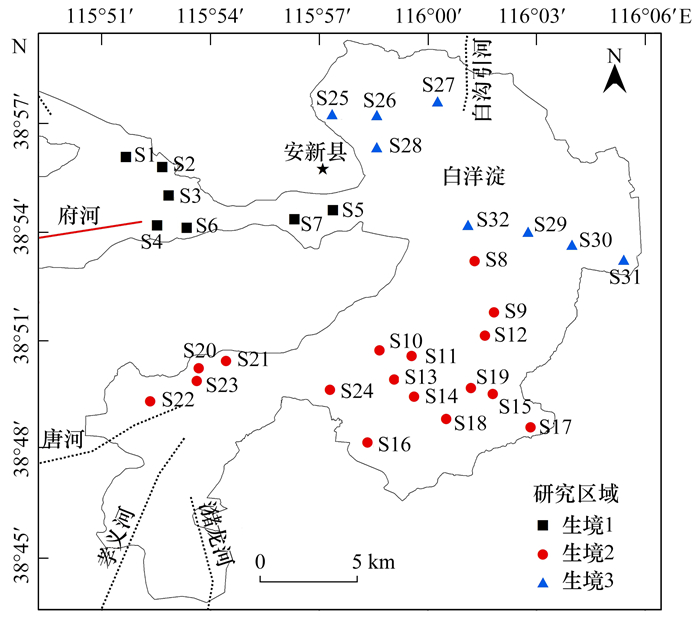
|
图 1 白洋淀采样点示意 Fig. 1 Sampling sites of Baiyangdian Lake |
依据白洋淀水体理化特征(表略), 将采样点进行聚类分析(图 2), 聚类结果显示S1~S7为生境1, S8~S24为生境2, S25~S32为生境3.生境1主要受上游保定市城市污水影响, 生境2主要受当地水产养殖废水和居民生活污水影响, 生境3受人类活动干扰较少.

|
图 2 依据水体理化参数的聚类分析 Fig. 2 Classification analysis results for sampling sites based on physical and chemical attributes in water |
水样预处理和QNs质量浓度测定方法参考文献[25].
鱼类样品运回实验室后于-50℃条件下冷冻干燥, 然后粉碎, 过10目筛子, 筛下物于-20℃条件下装袋标记, 冷冻保存, 以备分析[31].鱼类样品中QNs含量测定方法如下:称取0.5 g鱼粉末于暗处放置24 h后, 倒入快速溶剂萃取仪(吉天APLE-3000多通道全自动快速溶剂萃取仪)的萃取池, 加入适量硅藻土.提取溶剂为丙酮/甲醇(1/1, 体积比).工作条件如下:萃取温度为70℃; 萃取压力为1 500 psi(10 350 kPa); 预热5 min; 静态萃取5 min; 最终萃取体积60 mL, 冲洗体积为萃取池体积的60%;氮气吹扫90 s; 萃取循环3次.萃取液用旋转蒸发仪浓缩至2 mL, 然后用蒸馏水稀释至500 mL.剩余操作同水样分析.
本研究的目标抗生素为14种QNs:环丙沙星(ciprofloxacin, CIP)、达氟沙星(difloxacin, DIF)、依诺沙星(enoxacin, ENO)、恩诺沙星(enrofloxacin, ENR)、氟罗沙星(fleroxacin, FLE)、氟甲喹(flumequine, FLU)、马波沙星(marbofloxacin, MAR)、诺氟沙星(norfloxacin, NOR)、氧氟沙星(ofloxacin, OFL)、沙氟沙星(sarafloxacin, SAR)、司帕沙星(sparfloxacin, SPA)、奥比沙星(orbifloxacin, ORB)、喹酸(oxolinic acid, OXO)和吡哌酸(pipemidic acid, PIP).本研究使用安捷伦1200超高效液相色谱-电喷雾串联质谱(high performance liquid chromatography-electrospray ionization tandem mass spectrometry, HPLC-ESI-MS-MS)和多反应监测(multiple reaction monitoring, MRM)分析样品中QNs含量.
1.3 QNs在鱼类中的富集和传递鱼类对QNs的累积效应用生物累积系数(bioaccumulation factors, BAF)表征[32], 计算公式如下:

|
(1) |
式中, C鱼为鱼体内QNs含量(ng ·g-1), C水为水体中QNs的质量浓度(ng ·L-1).
QNs在鱼类中的营养传递水平用营养放大因子(trophic magnification factor, TMF)表征, 计算公式如下:

|
(2) |

|
(3) |
式中, TL为鱼类的营养级, a为y轴的截距, b为斜率.
鱼类的营养级根据文献[33]计算:

|
(4) |
式中, δ15 N鱼是鱼类的同位素值, δ15 N基准是基准生物(中国圆田螺)的平均同位素值, 其值选择之前研究[5]中的数值[10.36‰(生境1)、9.43‰(生境2)和8.74‰(生境3)]计算, 2.98是每个营养级水平的预期δ15 N值[34], 2是基线生物(中国圆田螺)的理论营养级水平[33, 35].白洋淀鱼类同位素δ15 N分析和结果详见文献[5].
1.4 健康风险评估方法为评估食用QNs污染鱼类的潜在健康风险, 根据鱼类体内QNs计算日估摄入量(estimated daily intake, EDI)[36].计算公式如下:

|
(5) |
式中, C鱼为鱼体内QNs含量(μg ·g-1), FR为中国成年人日估摄入鱼量(g ·d-1), 依据《中国食物与营养发展纲要(2014~2020年)》, FR取49.30 g ·d-1; BW为设定的成人平均体重(kg), 按60 kg计算.
本研究用危害系数(hazard quotient, HQ)表征健康风险[37], 计算公式如下:

|
(6) |
式中, ADI为日均可接受摄入量, 依据联合国粮食农业组织, 世界卫生组织和相关文献[38]可知, CIP、ENR、FLU、NOR和OFL的ADI分别为1.6、2.0、30.0、11.4和5.7 μg ·(kg ·d)-1.
本研究中利用危害指数(hazard index, HI=ΣHQ)计算食用白洋淀鱼类的健康风险[9].当HI<0.01表示该健康风险可忽略; 当HI≥0.01表示健康风险较大[39].
1.5 数据统计与分析采用SPSS 22.0软件进行统计分析和单因素方差检验(One-way ANOVA), P<0.05表明存在显著差异.利用ArcGIS 10.7软件和Origin 2018软件制图. BAF和TMF与环境因子间的相关性采用SPSS 22.0软件进行Spearman秩相关分析.
2 结果与分析 2.1 白洋淀水体理化和QNs的分布特征白洋淀水体理化参数表明(表 1), 大部分理化参数(COD、TP、TN、NH4+-N、NO3--N和PO43--P)呈现生境1>生境2>生境3的趋势, 其中DO、COD、TP和TN超出Ⅲ类水水质标准(GB 3838-2002).白洋淀水体中共检出11种QNs, FLU检出率最高, 其次为OXO和OFL; ΣQNs质量浓度范围为0.740 0~1 590 ng ·L-1, FLU平均质量浓度最高(168.0 ng ·L-1), 除PIP、OXO、FLU和ENO外, 其余QNs均呈现生境1>生境2>生境3的趋势(图 3).单因素方差检验结果表明(表略), PIP、MAR、NOR和ENO在3类生境中呈现显著差异(P<0.05), 其它QNs差异不显著.
|
|
表 1 水体理化特征 Table 1 Physico-chemical parameters in water samples |
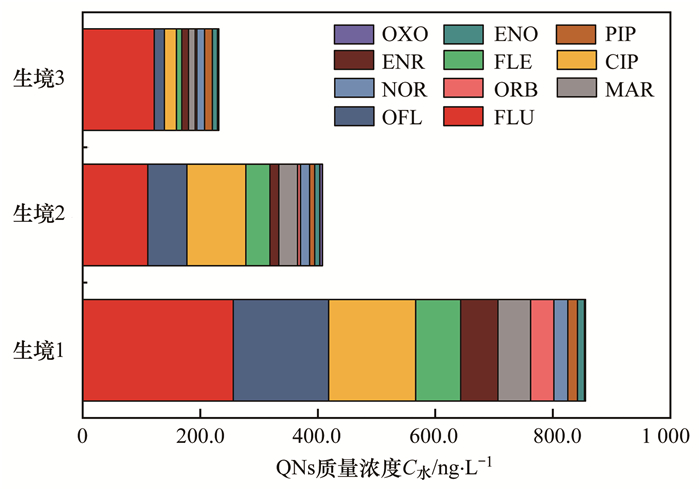
|
图 3 白洋淀水体QNs质量浓度 Fig. 3 Mass concentration of QNs in Baiyangdian Lake |
白洋淀鱼类样品中共检出9种QNs, 其中FLU和OFL检出率最高(100%), 其次为NOR、ENR和MAR(≥50.0%), QNs平均含量(ng ·g-1)范围为1.85(ENO)~28.1(CIP)(图 4).鱼类体内ΣQNs含量范围为17.1~146 ng ·g-1, 其中泥鳅体内ΣQNs平均含量最高(80.4 ng ·g-1), 黄黝鱼体内ΣQNs平均含量最低(28.5 ng ·g-1). CIP(28.1 ng ·g-1)和FLU(27.3 ng ·g-1)在鱼类体内的平均含量高于其它QNs(<15.0 ng ·g-1).就空间差异而言, 除ENO、FLU和PIP外, 其余QNs均呈现生境1>生境2>生境3, 与水体中QNs质量浓度空间分布一致.
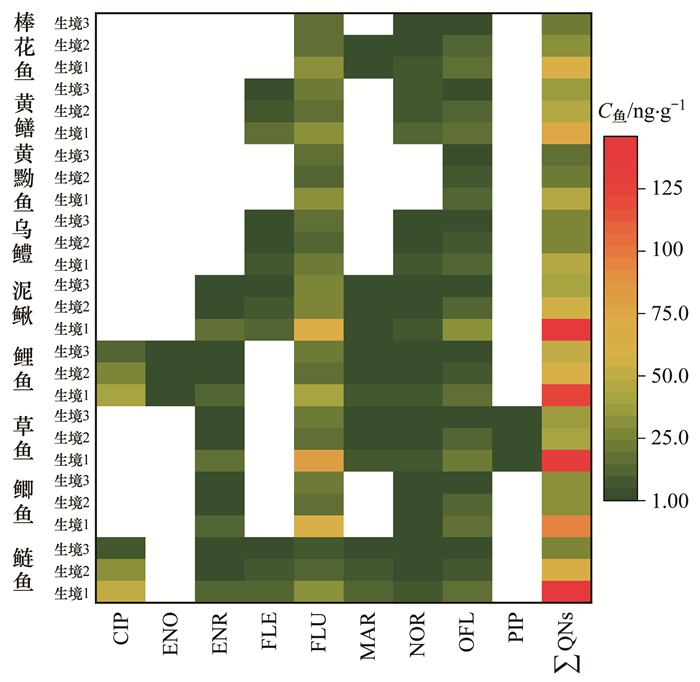
|
空白部分表示未检出 图 4 鱼类体内QNs含量特征 Fig. 4 Characteristics of QNs concentrations in fish species |
不同QNs在不同鱼类中的含量存在差异(图 5), 鲢鱼、鲤鱼、草鱼和泥鳅中QNs检出种类较多(>5种).就QNs种类而言, 鱼类体内FLU平均相对含量最高(52%), 其次为OFL(18%), 与水体中各QNs相对质量浓度基本一致, 表明鱼体内与其生活的水环境中QNs相对含量特征具有一定相似性.
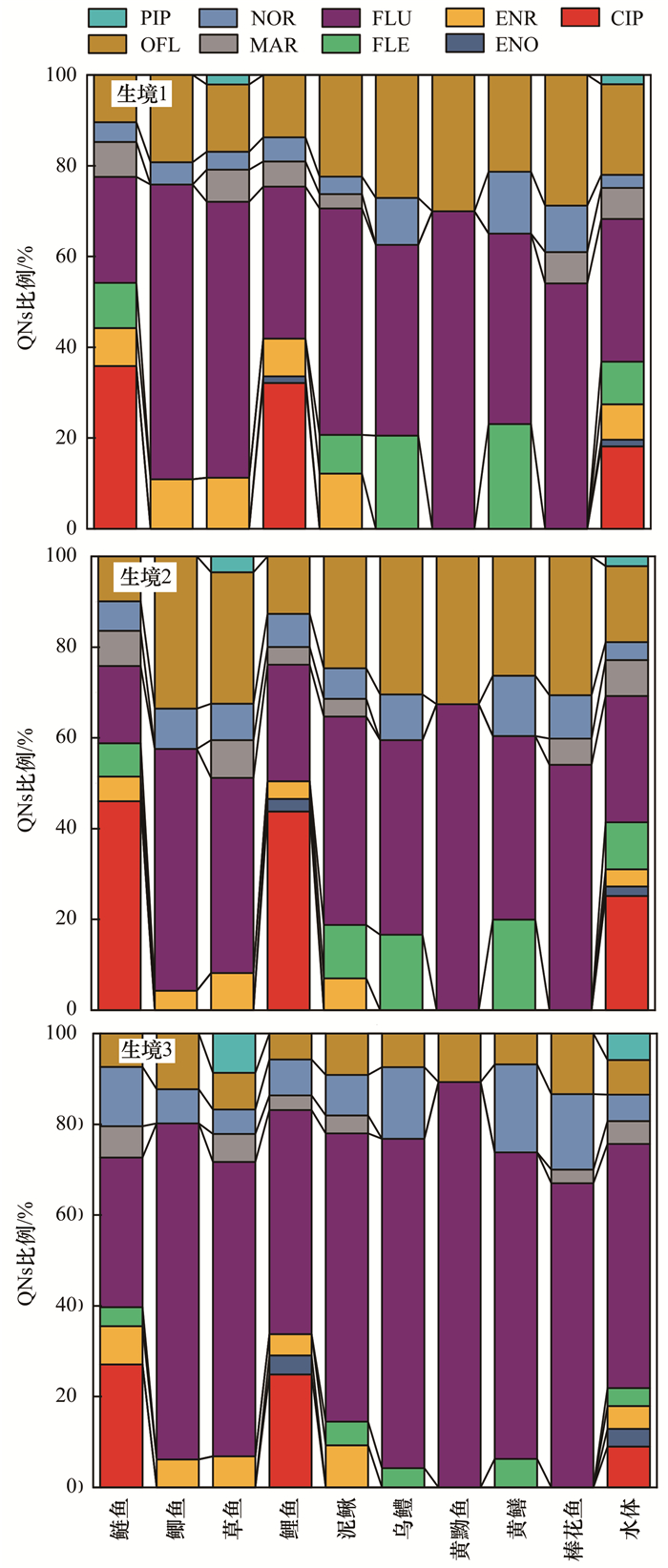
|
图 5 白洋淀3个生境鱼类及水体中QNs丰度特征 Fig. 5 Characteristics of QNs in fish species and water of three habitats in Baiyangdian Lake |
白洋淀优势鱼类中QNs的BAF结果见图 6和表 2.就优势鱼类的BAF差异而言(图 6), 鲤鱼的BAF平均值最高(163 L ·kg-1), 黄黝鱼的BAF平均值最低(58.3 L ·kg-1); 鲤鱼、乌鳢、黄鳝和棒花鱼的BAF呈现生境3>生境2>生境1, 鲫鱼、草鱼、泥鳅和黄黝鱼的BAF则在生境2值最小.就QNs种类差异而言(表 2), BAFCIP平均值最高(361 L ·kg-1), BAFMAR的平均值最低(122 L ·kg-1); BAF在生境1、生境2和生境3的范围(L ·kg-1)分别为111(BAFOFL)~309(BAFCIP)、96.2(BAFMAR)~286(BAFCIP)和140(BAFMAR)~489(BAFCIP).
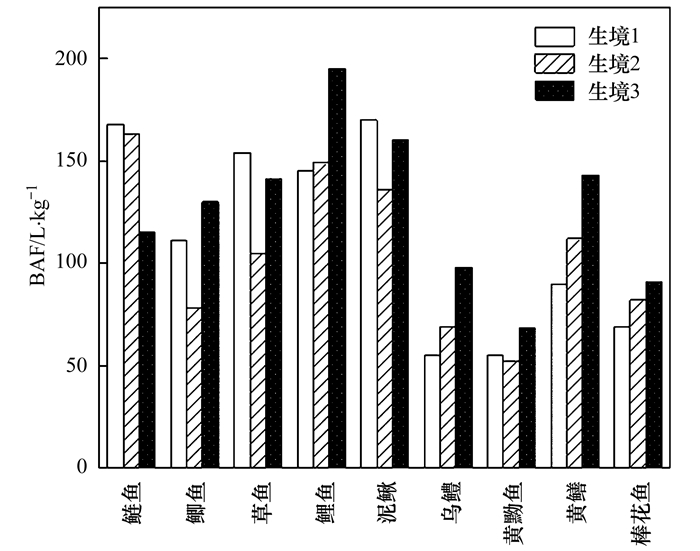
|
图 6 鱼类QNs的BAF Fig. 6 BAF of QNs in fish |
|
|
表 2 白洋淀3个生境中鱼类体内QNs的BAF/L·kg-1 Table 2 Observed BAF of QNs in fish from three habitats in Baiyangdian Lake/L·kg-1 |
不同生境的鱼类δ15 N稳定同位素数据存在差异性(表 3), 生境1[11.36‰(鲤鱼)~15.34‰(乌鳢)]和生境2[10.62‰(鲤鱼)~14.80‰(乌鳢)]的δ15 N高于生境3[9.722‰(鲤鱼)~14.35‰(乌鳢)].就鱼种类而言, 鲤鱼的δ15 N值最低, 乌鳢的最高. 3个生境中各鱼类营养级(TL)范围为2.33~3.88, TL值空间分布为生境3(2.33~3.88)>生境2(2.40~3.80)>生境1(2.33~3.67).
|
|
表 3 白洋淀鱼类δ15 N稳定同位素和营养级(TL)空间差异 Table 3 Spatial variation in stable isotope diagram (δ15 N) and trophic level (TL) of fish in Baiyangdian Lake |
本研究中, 鱼类体内QNs检出率存在较大差异, 因此, 选择检出率>50%的QNs(ENR、FLU、MAR、NOR、OFL)和ΣQNs计算TMF值(图 7), 3个生境中各QNs的TMF范围为0.714(TMFMAR, 生境3)~1.33(TMFENR, 生境3), MAR和OFL的TMF值在生境2最大, ENR、FLU和NOR的TMF值在生境3最大.就QNs而言, TMF呈现出TMFENR>TMFNOR>TMFOFL>TMFFLU>TMFMAR.
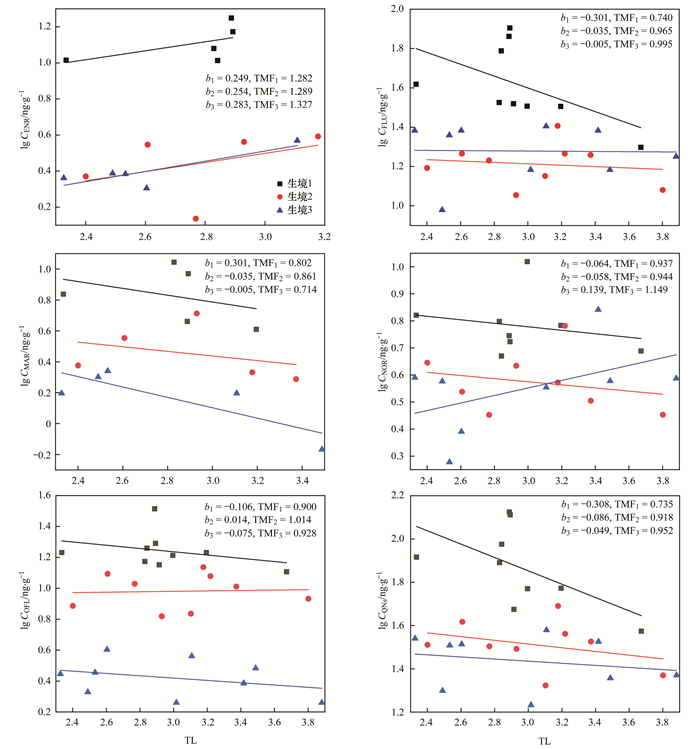
|
b1、b2和b3分别为生境1、生境2和生境3中对应的公式(2)中的b值; TMF1、TMF2和TMF3分别为生境1、生境2和生境3中鱼类的营养放大因子(TMF) 图 7 3个生境中鱼类体内QNs含量对数与TL的关系 Fig. 7 Relationships between log-transformed concentrations of QNs and trophic levels (TL) in fish from three habitats |
Spearman秩相关分析结果表明(表 4), 理化因子与BAF/TMF存在相关性.除WD外, 其余水体理化因子均与BAF和TMF显著相关(P<0.05或P<0.01), 其中pH与BAF呈负相关, 与TMF呈正相关; BAFENO、BAFOFL、BAFPIP、TMFENR、TMFFLU、TMFNOR和TMFQNs与T、SD和DO显著正相关, 与COD、TP、TN、NH4+-N、NO3--N和PO43--P显著负相关.
|
|
表 4 环境因子与QNs的BAF/TMF的Spearman相关性 Table 4 Spearman rank correlation between environmental factors and the BAF/TMF of QNs |
2.5 白洋淀食用鱼的健康风险
各QNs的健康风险如图 8所示.就各QNs而言, HQCIP(0.0040~0.026)显著高于其他QNs的HQ(<0.005 0).就空间差异而言, 生境1的HQ值最高, 生境3最低, 与水体QNs质量浓度和鱼类中QNs含量趋势一致. HI范围为0.001~0.035, HI鲢鱼, 生境1(0.035)、HI鲢鱼, 生境2(0.019)、HI草鱼, 生境1(0.012)、HI鲤鱼, 生境1(0.029)、HI鲤鱼, 生境2(0.016)和HI泥鳅, 生境1(0.014)均大于0.01, 处于高健康风险水平, 表明食用白洋淀鱼类存在较大风险.就各鱼类而言, 鲢鱼、鲤鱼的食用风险显著高于其他鱼类.
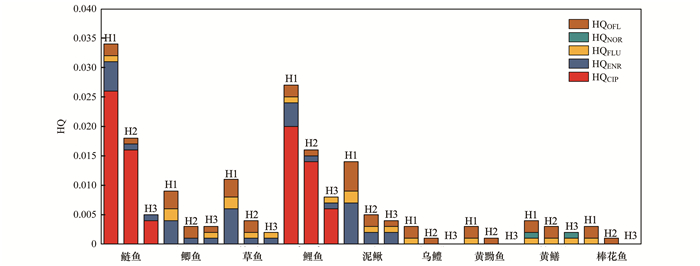
|
H1、H2和H3分别代表生境1、生境2和生境3 图 8 白洋淀鱼类体内QNs的HQ Fig. 8 HQ for QNs in Baiyangdian Lake fish |
QNs在我国地表水环境中被广泛检出, 其在水体中的质量浓度量级从ng ·L-1到μg ·L-1.本研究中白洋淀水体中ΣQNs的质量浓度范围为0.740 0~1 590 ng ·L-1, 高于巢湖[40]、博斯腾湖[41]、洪湖[42]、鄱阳湖[43]和长江南段[44]等水域, 低于太湖贡湖湾[45]等, 这与水体周围环境密切相关.而与之前的白洋淀研究相比, 本研究结果水体中的ΣQNs质量浓度低于Cheng等[28]的研究结果, 这可能是因为近些年国家政府加大了对畜禽业和渔业中的抗生素使用的管控[46], 降低了QNs的排放.
白洋淀鱼体内QNs水平(91.8 ng ·g-1)高于莱州湾(56.0 ng ·g-1)[9], 鱼体CIP含量(ND~51.5 ng ·g-1)高于珠江三角洲(4.61~33.3 ng ·g-1)[26]和海河(1.67~12.5 ng ·g-1)[6], 而鱼体NOR含量(ND~10.5 ng ·g-1)则低于珠江三角洲(3.38~101 ng ·g-1)[26]和海河(0.500~51.6 ng ·g-1)[6], 各地区抗生素使用水平不同, 导致水体抗生素污染也存在差异.
3.2 白洋淀QNs在鱼体内的生物累积及其与环境因子相关性白洋淀3个生境中鱼体内9种QNs的BAF范围为: 96.2 L ·kg-1(BAFMAR, 生境2)~489 L ·kg-1 (BAFCIP, 生境3), 小于1 000 L ·kg-1, 表明QNs在鱼类体内的生物富集相对较低[32]. BAFOFL、BAFNOR、BAFCIP和BAFENR的平均值分别为139、265、361和210 L ·kg-1, 低于太湖和之前的白洋淀研究结果[88.0~214 L ·kg-1(BAFOFL)、251~512 L ·kg-1(BAFNOR)、545~2 008 L ·kg-1(BAFCIP)和4 490 L ·kg-1(BAFENR)][23, 24].环境因子对抗生素的归趋和残留起着重要的作用[47, 48], 这种现象可能是环境因子在不同地区的时空差异所导致[24, 49].
本研究中的TMFOFL(0.900~1.01)和TMFENR(1.28~1.33)高于之前的白洋淀研究中的值(0.380~0.520)[23], TMFNOR(0.937~1.15)低于太湖[24]和莱州湾[9]中的值(1.24~1.25).由文献[50]可知, 白洋淀中ENR、生境3的NOR和生境2的OFL呈营养放大, 其他QNs(FLU、MAR、生境1和生境2的NOR、生境1和生境3的OFL、ΣQNs)呈营养稀释, 与之前的研究结果基本一致[24, 51].而目前抗生素的生物稀释机制尚不明晰, 但可推测其与环境因子密切相关.
白洋淀QNs的BAF/TMF与环境因子的相关性结果表明, pH、T、SD、DO、COD、TP、TN、NH4+-N、NO3--N和PO43--P与QNs在鱼类体内富集和传递显著相关.有研究发现QNs具有较强的吸附能力(吸附系数高达260~5 012 L ·kg-1)[52], 可与水环境中的有机质发生吸附作用, 沉降于沉积物中, 进而导致水环境中QNs浓度降低, 最终鱼类对QNs的生物累积降低.有研究表明[49], 黄海南部和长江口中pH对抗生素的富集存在影响.另外当环境条件(pH、离子条件等)发生变化时, 沉积物中的抗生素解吸附进入水环境中, 最终被生物富集.因此, 理化参数是影响抗生素生物富集和传递的重要因素, 且pH对其影响极大[53].有研究表明, pH可影响抗生素的解离, 而非解离形态的抗生素易跨过细胞膜被生物吸附[54]. Bergsjø等[55]的研究发现pH可影响虹鳟鱼对磺胺二甲嘧啶的生物富集, 在pH为7~8时, 生物富集能力最强.温度可以通过影响抗生素在水中和生物膜之间扩散过程、抗生素和蛋白质的结合速率和类脂物成分发生改变等, 进而影响抗生素的生物吸附和释放.另有研究表明, 水体中其它污染物、盐度和离子强度等均可影响抗生素的形态和理化特性[56, 57], 从而影响抗生素的生物富集和营养传递.
4 结论(1) 白洋淀水体中QNs存在显著空间差异, 鱼类体内QNs也存在空间和物种差异性.
(2) 鱼类对QNs的生物富集能力在生境3最高, 其次为生境2和生境1; ENR呈营养放大, FLU、MAR和ΣQNs呈营养稀释.
(3) pH、T、SD、DO、COD、TP、TN、NH4+-N、NO3--N和PO43--P与QNs在鱼类体内的生物富集和传递显著相关.
(4) 白洋淀鱼类整体存在较大的食用健康风险, 因此, 应制定更为严格的抗生素排放标准, 减少湖泊外源有机质和营养物质输入, 以降低抗生素污染水平和健康风险.
| [1] | Chung H S, Lee Y J, Rahman M, et al. Uptake of the veterinary antibiotics chlortetracycline, enrofloxacin, and sulphathiazole from soil by radish[J]. Science of the Total Environment, 2017, 605-606: 322-331. DOI:10.1016/j.scitotenv.2017.06.231 |
| [2] |
张盼伟.海河流域典型水体中PPCPs的环境行为及潜在风险研究[D].北京: 中国水利水电科学研究院, 2018.1-3, 35-37. Zhang P W. Environmental behavior and pollution characteristics of pharmaceuticals and personal care products, and their associated environmental risks in typical water-body from Haihe River basin, China[D]. Beijing: China Institute of Water Resources and Hydropower Research, 2018.1-3, 35-37. http://cdmd.cnki.com.cn/Article/CDMD-82301-1018178139.htm |
| [3] | Carvalho I T, Santos L. Antibiotics in the aquatic environments:a review of the European scenario[J]. Environment International, 2016, 94: 736-757. DOI:10.1016/j.envint.2016.06.025 |
| [4] | Yang S F, Lin C F, Lin A Y C, et al. Sorption and biodegradation of sulfonamide antibiotics by activated sludge:experimental assessment using batch data obtained under aerobic conditions[J]. Water Research, 2011, 45(11): 3389-3397. DOI:10.1016/j.watres.2011.03.052 |
| [5] | Zhang L L, Qin S, Shen L N, et al. Bioaccumulation, trophic transfer, and human health risk of quinolones antibiotics in the benthic food web from a macrophyte-dominated shallow lake, North China[J]. Science of the Total Environment, 2020, 712: 136557. DOI:10.1016/j.scitotenv.2020.136557 |
| [6] | Gao L H, Shi Y L, Li W H, et al. Occurrence, distribution and bioaccumulation of antibiotics in the Haihe River in China[J]. Journal of Environmental Monitoring, 2012, 14(4): 1247-1254. |
| [7] | Bouki C, Venieri D, Diamadopoulos E. Detection and fate of antibiotic resistant bacteria in wastewater treatment plants:a review[J]. Ecotoxicology and Environmental Safety, 2013, 91: 1-9. DOI:10.1016/j.ecoenv.2013.01.016 |
| [8] | Deng W J, Li N, Zheng H L, et al. Occurrence and risk assessment of antibiotics in river water in Hong Kong[J]. Ecotoxicology and Environmental Safety, 2016, 125: 121-127. DOI:10.1016/j.ecoenv.2015.12.002 |
| [9] | Liu S S, Zhao H X, Lehmler H J, et al. Antibiotic pollution in marine food webs in Laizhou Bay, North China:trophodynamics and human exposure implication[J]. Environmental Science & Technology, 2017, 51(4): 2392-2400. |
| [10] | Liu X H, Lu S Y, Guo W, et al. Antibiotics in the aquatic environments:a review of lakes, China[J]. Science of the Total Environment, 2018, 627: 1195-1208. DOI:10.1016/j.scitotenv.2018.01.271 |
| [11] | Kümmerer K. Antibiotics in the aquatic environment-A review-Part Ⅰ[J]. Chemosphere, 2009, 75(4): 417-434. DOI:10.1016/j.chemosphere.2008.11.086 |
| [12] | Wu W, Zhao X H, Liu X, et al. The review of antibiotics in the global water environment[A]. In: Proceedings of 2011 International Conference on Multimedia Technology[C]. Hangzhou: IEEE, 2011.4205-4208. |
| [13] | Robinson A A, Belden J B, Lydy M J. Toxicity of fluoroquinolone antibiotics to aquatic organisms[J]. Environmental Toxicology and Chemistry, 2005, 24(2): 423-430. DOI:10.1897/04-210R.1 |
| [14] | Cheng D M, Liu X H, Zhao S N, et al. Influence of the natural colloids on the multi-phase distributions of antibiotics in the surface water from the largest lake in North China[J]. Science of the Total Environment, 2017, 578: 649-659. DOI:10.1016/j.scitotenv.2016.11.012 |
| [15] |
孙秋根, 王智源, 董建玮, 等. 太湖流域河网4种典型抗生素的时空分布和风险评价[J]. 环境科学学报, 2018, 38(11): 4400-4410. Sun Q G, Wang Z Y, Dong J W, et al. Spatial-temporal distribution and risk evaluation of four typical antibiotics in river networks of Taihu Lake Basin[J]. Acta Scientiae Circumstantiae, 2018, 38(11): 4400-4410. |
| [16] |
张国栋.南四湖流域典型抗生素时空分布及迁移规律研究[D].济南: 山东师范大学, 2019.21-26. Zhang G D. Spatial and temporal distribution and migration of typical antibiotics in Nansihu Lake basin[D]. Ji'nan: Shandong Normal University, 2019.21-26. |
| [17] |
刘昔, 王智, 王学雷, 等. 我国典型区域地表水环境中抗生素污染现状及其生态风险评价[J]. 环境科学, 2019, 40(5): 2094-2100. Liu X, Wang Z, Wang X L, et al. Status of antibiotic contamination and ecological risks assessment of several typical Chinese surface-water environments[J]. Environmental Science, 2019, 40(5): 2094-2100. |
| [18] | Yao L L, Wang Y X, Tong L, et al. Occurrence and risk assessment of antibiotics in surface water and groundwater from different depths of aquifers:a case study at Jianghan Plain, central China[J]. Ecotoxicology and Environmental Safety, 2017, 135: 236-242. DOI:10.1016/j.ecoenv.2016.10.006 |
| [19] |
陈卫平, 彭程伟, 杨阳, 等. 北京市地下水中典型抗生素分布特征与潜在风险[J]. 环境科学, 2017, 38(12): 5074-5080. Chen W P, Peng C W, Yang Y, et al. Distribution characteristics and risk analysis of antibiotic in the groundwater in Beijing[J]. Environmental Science, 2017, 38(12): 5074-5080. |
| [20] | Zhang R J, Zhang G, Tang J H, et al. Levels, spatial distribution and sources of selected antibiotics in the East River (Dongjiang), South China[J]. Aquatic Ecosystem Health & Management, 2012, 15(2): 210-218. |
| [21] |
廖杰, 魏晓琴, 肖燕琴, 等. 莲花水库水体中抗生素污染特征及生态风险评价[J]. 环境科学, 2020, 41(9): 4081-4087. Liao J, Wei X Q, Xiao Y Q, et al. Pollution characteristics and risk assessment of antibiotics in Lianhua Reservoir[J]. Environmental Science, 2020, 41(9): 4081-4087. |
| [22] | Liu K, Yin X F, Zhang D L, et al. Distribution, sources, and ecological risk assessment of quinotone antibiotics in the surface sediments from Jiaozhou Bay wetland, China[J]. Marine Pollution Bulletin, 2018, 129(2): 859-865. DOI:10.1016/j.marpolbul.2017.10.010 |
| [23] | Li W H, Shi Y L, Gao L H, et al. Occurrence of antibiotics in water, sediments, aquatic plants, and animals from Baiyangdian Lake in North China[J]. Chemosphere, 2012, 89(11): 1307-1315. DOI:10.1016/j.chemosphere.2012.05.079 |
| [24] | Xie Z X, Lu G H, Yan Z H, et al. Bioaccumulation and trophic transfer of pharmaceuticals in food webs from a large freshwater lake[J]. Environmental Pollution, 2017, 222: 356-366. DOI:10.1016/j.envpol.2016.12.026 |
| [25] |
刘思思.抗生素在莱州湾近岸食物网中的生物积累与食物链传递[D].大连: 大连理工大学, 2018.76-91. Liu S S. Bioaccumulation and trophic transfer of antibiotics in a food web from coastal area of Laizhou Bay[D]. Dalian: Dalian University of Technology, 2018.76-91. |
| [26] | Zhao J L, Liu Y S, Liu W R, et al. Tissue-specific bioaccumulation of human and veterinary antibiotics in bile, plasma, liver and muscle tissues of wild fish from a highly urbanized region[J]. Environmental Pollution, 2015, 198: 15-24. DOI:10.1016/j.envpol.2014.12.026 |
| [27] |
申立娜, 张璐璐, 秦珊, 等. 白洋淀喹诺酮类抗生素污染特征及其与环境因子相关性研究[J]. 环境科学学报, 2019, 39(11): 3888-3897. Shen L N, Zhang L L, Qin S, et al. The occurrence and distribution of quinolones (QNs) and correlation analysis between QNs and physical-chemical parameters in Baiyangdian Lake, North China[J]. Acta Scientiae Circumstantiae, 2019, 39(11): 3888-3897. |
| [28] | Cheng D M, Liu X H, Wang L, et al. Seasonal variation and sediment-water exchange of antibiotics in a shallower large lake in North China[J]. Science of the Total Environment, 2014, 476-477: 266-275. DOI:10.1016/j.scitotenv.2014.01.010 |
| [29] | Zhang L L, Shen L N, Qin S, et al. Quinolones antibiotics in the Baiyangdian Lake, China:Occurrence, distribution, Predicted No-Effect Concentrations (PNECs) and ecological risks by three methods[J]. Environmental Pollution, 2020, 256: 113458. DOI:10.1016/j.envpol.2019.113458 |
| [30] | Borgå K, Kidd K A, Muir D C G, et al. Trophic magnification factors:considerations of ecology, ecosystems, and study design[J]. Integrated Environmental Assessment and Management, 2012, 8(1): 64-84. DOI:10.1002/ieam.244 |
| [31] |
刘叶新, 周志洪, 区晖, 等. 珠江广州河段沉积物中典型抗生素的污染特征[J]. 华南师范大学学报(自然科学版), 2018, 50(4): 48-54. Liu Y X, Zhou Z H, Ou H, et al. Occurrence of typical antibiotics in sediments of Guangzhou section of the Pearl River[J]. Journal of South China Normal University (Natural Science Edition), 2018, 50(4): 48-54. |
| [32] | Arnot J A, Gobas F A P C. A review of bioconcentration factor (BCF) and bioaccumulation factor (BAF) assessments for organic chemicals in aquatic organisms[J]. Environmental Reviews, 2006, 14(4): 257-297. DOI:10.1139/a06-005 |
| [33] | Post D M. Using stable isotopes to estimate trophic position:models, methods, and assumptions[J]. Ecology, 2002, 83(3): 703-718. DOI:10.1890/0012-9658(2002)083[0703:USITET]2.0.CO;2 |
| [34] | Vanderklift M A, Ponsard S. Sources of variation in consumer-diet δ15 N enrichment:a meta-analysis[J]. Oecologia, 2003, 136(2): 169-182. DOI:10.1007/s00442-003-1270-z |
| [35] | Iglesias C, Meerhoff M, Johansson L S, et al. Stable isotope analysis confirms substantial differences between subtropical and temperate shallow lake food webs[J]. Hydrobiologia, 2017, 784(1): 111-123. DOI:10.1007/s10750-016-2861-0 |
| [36] | World Health Organisation, Food Griculture Organisation. Evaluation of certain food additives and contaminants (Technical Report No.751)[R]. Cambridge, England: Cambridge University Press, 1987. |
| [37] | EPA/540/R-92/003, Risk assessment guidance for superfund, volume 1, human health evaluation manual (Part B, development of risk-based preliminary remediation goals)[S]. |
| [38] | Kim Y, Jung J Y, Kim M, et al. Prioritizing veterinary pharmaceuticals for aquatic environment in Korea[J]. Environmental Toxicology and Pharmacology, 2008, 26(2): 167-176. |
| [39] | Vragović N, Bažulić D, Njari B. Risk assessment of streptomycin and tetracycline residues in meat and milk on Croatian market[J]. Food and Chemical Toxicology, 2011, 49(2): 352-355. DOI:10.1016/j.fct.2010.11.006 |
| [40] | Tang J, Shi T Z, Wu X W, et al. The occurrence and distribution of antibiotics in Lake Chaohu, China:seasonal variation, potential source and risk assessment[J]. Chemosphere, 2015, 122: 154-161. DOI:10.1016/j.chemosphere.2014.11.032 |
| [41] | Lei X N, Lu J J, Liu Z L, et al. Concentration and distribution of antibiotics in water-sediment system of Bosten Lake, Xinjiang[J]. Environmental Science and Pollution Research, 2015, 22(3): 1670-1678. DOI:10.1007/s11356-014-2994-5 |
| [42] | Wang Z, Du Y, Yang C, et al. Occurrence and ecological hazard assessment of selected antibiotics in the surface waters in and around Lake Honghu, China[J]. Science of the Total Environment, 2017, 609: 1423-1432. DOI:10.1016/j.scitotenv.2017.08.009 |
| [43] |
丁惠君, 钟家有, 吴亦潇, 等. 鄱阳湖流域南昌市城市湖泊水体抗生素污染特征及生态风险分析[J]. 湖泊科学, 2017, 29(4): 848-858. Ding H J, Zhong J Y, Wu Y X, et al. Characteristics and ecological risk assessment of antibiotics in five city lakes in Nanchang City, Lake Poyang Catchment[J]. Journal of Lake Sciences, 2017, 29(4): 848-858. |
| [44] |
封梦娟, 张芹, 宋宁慧, 等. 长江南京段水源水中抗生素的赋存特征与风险评估[J]. 环境科学, 2019, 40(12): 5286-5293. Feng M J, Zhang Q, Song N H, et al. Occurrence characteristics and risk assessment of antibiotics in source water of the Nanjing reach of the Yangtze River[J]. Environmental Science, 2019, 40(12): 5286-5293. |
| [45] |
武旭跃, 邹华, 朱荣, 等. 太湖贡湖湾水域抗生素污染特征分析与生态风险评价[J]. 环境科学, 2016, 37(12): 4596-4604. Wu X Y, Zhou H, Zhu R, et al. Occurrence, distribution and ecological risk of antibiotics in surface water of the Gonghu Bay, Taihu Lake[J]. Environmental Science, 2016, 37(12): 4596-4604. |
| [46] | 国务院食品安全办, 工业和信息化部, 农业部, 等.畜禽水产品抗生素、禁用化合物及兽药残留超标专项整治行动方案[R].国务院食品安全办, 工业和信息化部, 农业部, 2016. |
| [47] | Petrie B, Barden R, Kasprzyk-Hordern B, et al. A review on emerging contaminants in wastewaters and the environment:current knowledge, understudied areas and recommendations for future monitoring[J]. Water Research, 2015, 72: 3-27. DOI:10.1016/j.watres.2014.08.053 |
| [48] | Zhang S Y, Chen J W, Xie Q, et al. Effect of dissolved organic matter on the transformation of contaminants induced by excited triplet states and the hydroxyl radical[J]. Environmental Science & Technology, 2011, 45(18): 7945-7946. |
| [49] | Du B W, Haddad S P, Luek A, et al. Bioaccumulation of human pharmaceuticals in fish across habitats of a tidally influenced urban bayou[J]. Environmental Toxicology and Chemistry, 2016, 35(4): 966-974. DOI:10.1002/etc.3221 |
| [50] | Fisk A T, Hobson K A, Norstrom R J. Influence of chemical and biological factors on trophic transfer of persistent organic pollutants in the northwater polynya marine food web[J]. Environmental Science & Technology, 2001, 35(4): 732-738. |
| [51] | Du B W, Haddad S P, Luek A, et al. Bioaccumulation and trophic dilution of human pharmaceuticals across trophic positions of an effluent-dependent wadeable stream[J]. Philosophical Transactions of the Royal Society B:Biological Sciences, 2014, 369(1656): 20140058. DOI:10.1098/rstb.2014.0058 |
| [52] | Sarmah A K, Meyer M T, Boxall A B A. A global perspective on the use, sales, exposure pathways, occurrence, fate and effects of veterinary antibiotics (VAs) in the environment[J]. Chemosphere, 2006, 65(5): 725-759. DOI:10.1016/j.chemosphere.2006.03.026 |
| [53] | Nichols J W, Du B W, Berninger J P, et al. Observed and modeled effects of pH on bioconcentration of diphenhydramine, a weakly basic pharmaceutical, in fathead minnows[J]. Environmental Toxicology and Chemistry, 2015, 34(6): 1425-1435. DOI:10.1002/etc.2948 |
| [54] | Rendal C, Kusk K O, Trapp S. Optimal choice of pH for toxicity and bioaccumulation studies of ionizing organic chemicals[J]. Environmental Toxicology and Chemistry, 2011, 30(11): 2395-2406. DOI:10.1002/etc.641 |
| [55] | Bergsjø T, Bergsjø T H. Absorption from water as an alternative method for the administration of sulphonamides to rainbow trout, salmo gairdneri. The significance of the pKa value of the sulphonamides and the pH and salt content of the water[J]. Acta Veterinaria Scandinavica, 1978, 19(1): 102-109. |
| [56] | Chen Y, Zhou J L, Cheng L, et al. Sediment and salinity effects on the bioaccumulation of sulfamethoxazole in zebrafish (Danio rerio)[J]. Chemosphere, 2017, 180: 467-475. DOI:10.1016/j.chemosphere.2017.04.055 |
| [57] | Yan Z H, Lu G H, Sun H W, et al. Influence of multi-walled carbon nanotubes on the effects of roxithromycin in crucian carp (Carassius auratus) in the presence of natural organic matter[J]. Chemosphere, 2017, 178: 165-172. DOI:10.1016/j.chemosphere.2017.03.043 |
 2020, Vol. 41
2020, Vol. 41


